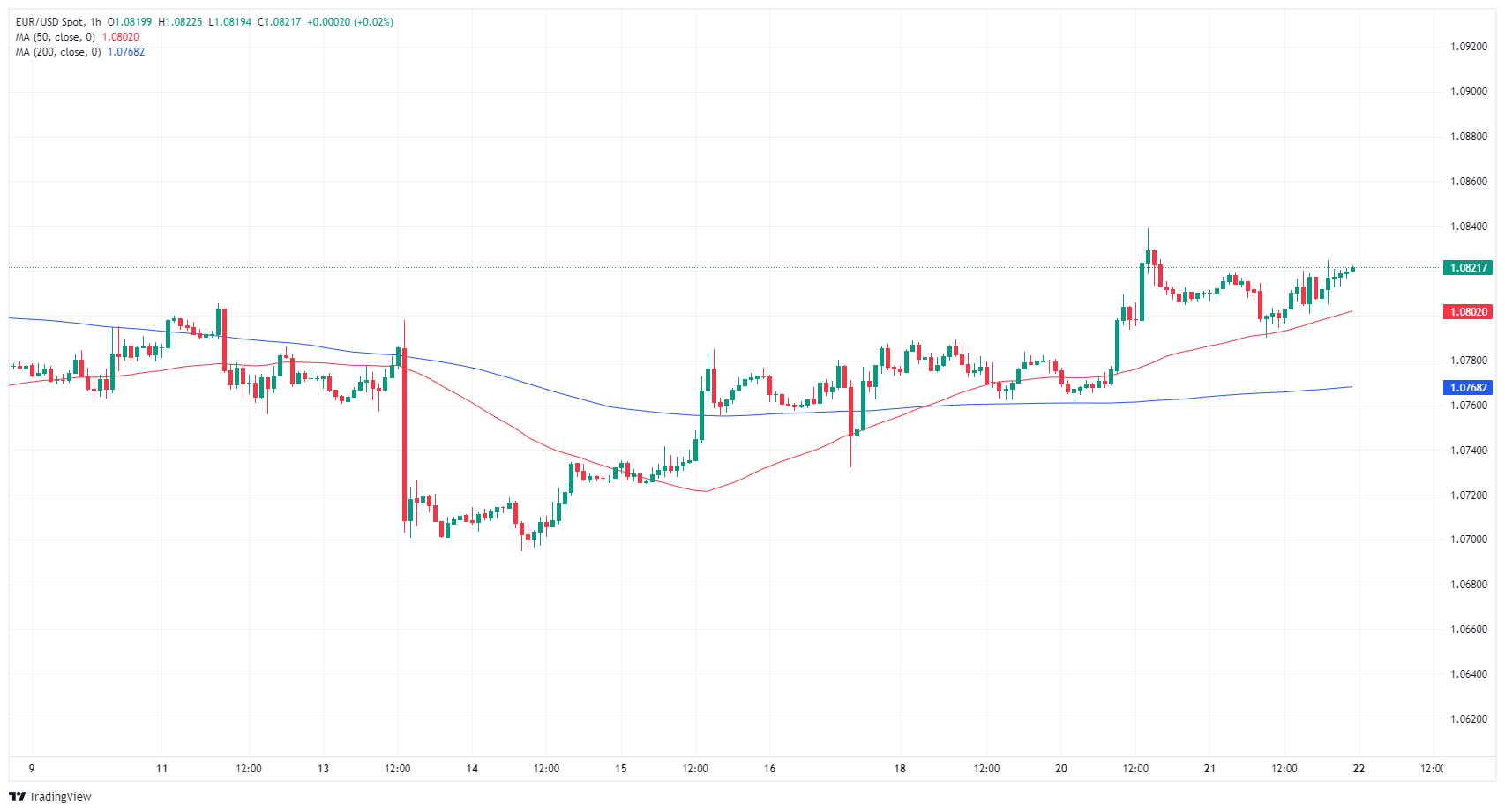- Markets shuffled after Fed Minutes which focused on downside risks.
- EU and US PMIs slated for Thursday.
- Friday rounds out the trading week with a smattering of ECB speeches.
EUR/USD drifted into the midrange before a late break into the high side on Wednesday after the US Federal Reserve (Fed) published its latest Minutes which showed policymakers continue to remain focused on downside risks. Inconsistent inflationary pressures in the US economy is keeping the Fed back from rate cuts, and policymakers continue to wait for further signs of inflation dropping to the Fed's desired target range. European and US Purchasing Managers Indices (PMIs) are slated for Thursday, where markets expect a slight improvement in the euro area and a softer print in US activity figures.
Friday wraps up the week with a smattering of speeches from policymakers from the European Central Bank (ECB). The Fed’s latest Monetary Policy Report also drops on Friday.
Daily digest market movers: EUR/USD pulls into the middle ahead of Fed Minutes
- The Fed's latest Minutes show key policymakers remain concerned that it could take longer than expected for inflation to return to target.
- The US' economic outlook is slightly stronger compared to December projections, and the Fed is worried that progress on bringing inflation down could stall.
- Fed Minutes suggest rates are at their peak
- The EU’s Consumer Confidence in February improved more than expected, printing at -15.5 versus the forecast -15.6, compared to the previous month’s print of -16.1.
- Thursday’s EU HCOB PMIs are broadly expected to recover, with the pan-euro area Composite PMI for February forecast to improve to 48.5 from 47.9.
- A below-50.0 print for the Composite component would represent a ninth straight month in contraction territory.
- Europe’s final Core Harmonized Index of Consumer Prices (HICP) inflation on Thursday is expected to confirm the preliminary print of 3.3% YoY.
- The US is expected to see a slight downtick in its PMI figures, with the Services component forecast to drop to 52.0 from 52.5 and the Manufacturing component expected to drop to 50.5 from 50.7.
- Forex Today: Markets now shift the attention to PMIs
Euro price this week
The table below shows the percentage change of Euro (EUR) against listed major currencies this week. Euro was the strongest against the Japanese Yen.
| USD | EUR | GBP | CAD | AUD | JPY | NZD | CHF | |
| USD | -0.35% | -0.22% | 0.16% | -0.22% | 0.17% | -0.74% | -0.17% | |
| EUR | 0.34% | 0.12% | 0.50% | 0.12% | 0.52% | -0.40% | 0.17% | |
| GBP | 0.22% | -0.13% | 0.38% | 0.00% | 0.39% | -0.52% | 0.05% | |
| CAD | -0.16% | -0.50% | -0.38% | -0.37% | 0.02% | -0.90% | -0.33% | |
| AUD | 0.23% | -0.12% | 0.00% | 0.38% | 0.40% | -0.52% | 0.05% | |
| JPY | -0.16% | -0.52% | -0.37% | -0.02% | -0.39% | -0.91% | -0.34% | |
| NZD | 0.74% | 0.39% | 0.51% | 0.89% | 0.52% | 0.90% | 0.56% | |
| CHF | 0.17% | -0.17% | -0.05% | 0.32% | -0.06% | 0.35% | -0.57% |
The heat map shows percentage changes of major currencies against each other. The base currency is picked from the left column, while the quote currency is picked from the top row. For example, if you pick the Euro from the left column and move along the horizontal line to the Japanese Yen, the percentage change displayed in the box will represent EUR (base)/JPY (quote).
Technical analysis: EUR/USD runs headfirst into 200-day SMA at 1.0830
EUR/USD remains on the bullish side of the 200-hour Simple Moving Average (SMA) near 1.0767 as the pair drifts into the high end in the near term. Price action has continued to extend a rough recovery from last week’s dip into the 1.0700 handle, but halting momentum sees bullish sentiment beginning to thin at the intraday level.
Daily candlesticks have the pair knocking into the 200-day SMA near 1.0830, and topside momentum is facing a significant technical ceiling. The EUR/USD is still facing a pattern of descending highs, and the pair is still down around 3% from December’s peak bids near 1.1140.
EUR/USD hourly chart
EUR/USD daily chart
Euro FAQs
What is the Euro?
The Euro is the currency for the 20 European Union countries that belong to the Eurozone. It is the second most heavily traded currency in the world behind the US Dollar. In 2022, it accounted for 31% of all foreign exchange transactions, with an average daily turnover of over $2.2 trillion a day.
EUR/USD is the most heavily traded currency pair in the world, accounting for an estimated 30% off all transactions, followed by EUR/JPY (4%), EUR/GBP (3%) and EUR/AUD (2%).
What is the ECB and how does it impact the Euro?
The European Central Bank (ECB) in Frankfurt, Germany, is the reserve bank for the Eurozone. The ECB sets interest rates and manages monetary policy.
The ECB’s primary mandate is to maintain price stability, which means either controlling inflation or stimulating growth. Its primary tool is the raising or lowering of interest rates. Relatively high interest rates – or the expectation of higher rates – will usually benefit the Euro and vice versa.
The ECB Governing Council makes monetary policy decisions at meetings held eight times a year. Decisions are made by heads of the Eurozone national banks and six permanent members, including the President of the ECB, Christine Lagarde.
How does inflation data impact the value of the Euro?
Eurozone inflation data, measured by the Harmonized Index of Consumer Prices (HICP), is an important econometric for the Euro. If inflation rises more than expected, especially if above the ECB’s 2% target, it obliges the ECB to raise interest rates to bring it back under control.
Relatively high interest rates compared to its counterparts will usually benefit the Euro, as it makes the region more attractive as a place for global investors to park their money.
How does economic data influence the value of the Euro?
Data releases gauge the health of the economy and can impact on the Euro. Indicators such as GDP, Manufacturing and Services PMIs, employment, and consumer sentiment surveys can all influence the direction of the single currency.
A strong economy is good for the Euro. Not only does it attract more foreign investment but it may encourage the ECB to put up interest rates, which will directly strengthen the Euro. Otherwise, if economic data is weak, the Euro is likely to fall.
Economic data for the four largest economies in the euro area (Germany, France, Italy and Spain) are especially significant, as they account for 75% of the Eurozone’s economy.
How does the Trade Balance impact the Euro?
Another significant data release for the Euro is the Trade Balance. This indicator measures the difference between what a country earns from its exports and what it spends on imports over a given period.
If a country produces highly sought after exports then its currency will gain in value purely from the extra demand created from foreign buyers seeking to purchase these goods. Therefore, a positive net Trade Balance strengthens a currency and vice versa for a negative balance.
Information on these pages contains forward-looking statements that involve risks and uncertainties. Markets and instruments profiled on this page are for informational purposes only and should not in any way come across as a recommendation to buy or sell in these assets. You should do your own thorough research before making any investment decisions. FXStreet does not in any way guarantee that this information is free from mistakes, errors, or material misstatements. It also does not guarantee that this information is of a timely nature. Investing in Open Markets involves a great deal of risk, including the loss of all or a portion of your investment, as well as emotional distress. All risks, losses and costs associated with investing, including total loss of principal, are your responsibility. The views and opinions expressed in this article are those of the authors and do not necessarily reflect the official policy or position of FXStreet nor its advertisers. The author will not be held responsible for information that is found at the end of links posted on this page.
If not otherwise explicitly mentioned in the body of the article, at the time of writing, the author has no position in any stock mentioned in this article and no business relationship with any company mentioned. The author has not received compensation for writing this article, other than from FXStreet.
FXStreet and the author do not provide personalized recommendations. The author makes no representations as to the accuracy, completeness, or suitability of this information. FXStreet and the author will not be liable for any errors, omissions or any losses, injuries or damages arising from this information and its display or use. Errors and omissions excepted.
The author and FXStreet are not registered investment advisors and nothing in this article is intended to be investment advice.
Recommended content
Editors’ Picks

EUR/USD trades sideways below 1.0450 amid quiet markets
EUR/USD defends gains below 1.0450 in European trading on Monday. Thin trading heading into the Xmas holiday and a modest US Dollar rebound leaves the pair in a familair range. Meanwhile, ECB President Lagarde's comments fail to impress the Euro.

GBP/USD stays defensive below 1.2600 after UK Q3 GDP revision
GBP/USD trades on the defensive below 1.2600 in the European session on Monday. The pair holds lower ground following the downward revision to the third-quarter UK GDP data, which weighs negatively on the Pound Sterling amid a broad US Dollar uptick.

Gold price sticks to modest gains; upside seems limited amid USD dip-buying
Gold price attracts some follow-through buying at the start of a new week and looks to build on its recovery from a one-month low touched last Thursday. Geopolitical risks stemming from the protracted Russia-Ukraine war and tensions in the Middle East, along with trade war fears, turn out to be key factors benefiting the safe-haven precious metal.

Let’s focus on the good for a few more days
Last week was chaotic. The Fed’s hawkish 25bp cut, the hint from the dot plot that there would be only two rate cuts next year instead of four – because the US economy is too strong to continue the cuts as previously predicted - and the US debt limit shenanigans even before Trump took office gave a negative jolt to the US stock markets.

Bank of England stays on hold, but a dovish front is building
Bank of England rates were maintained at 4.75% today, in line with expectations. However, the 6-3 vote split sent a moderately dovish signal to markets, prompting some dovish repricing and a weaker pound. We remain more dovish than market pricing for 2025.

Best Forex Brokers with Low Spreads
VERIFIED Low spreads are crucial for reducing trading costs. Explore top Forex brokers offering competitive spreads and high leverage. Compare options for EUR/USD, GBP/USD, USD/JPY, and Gold.